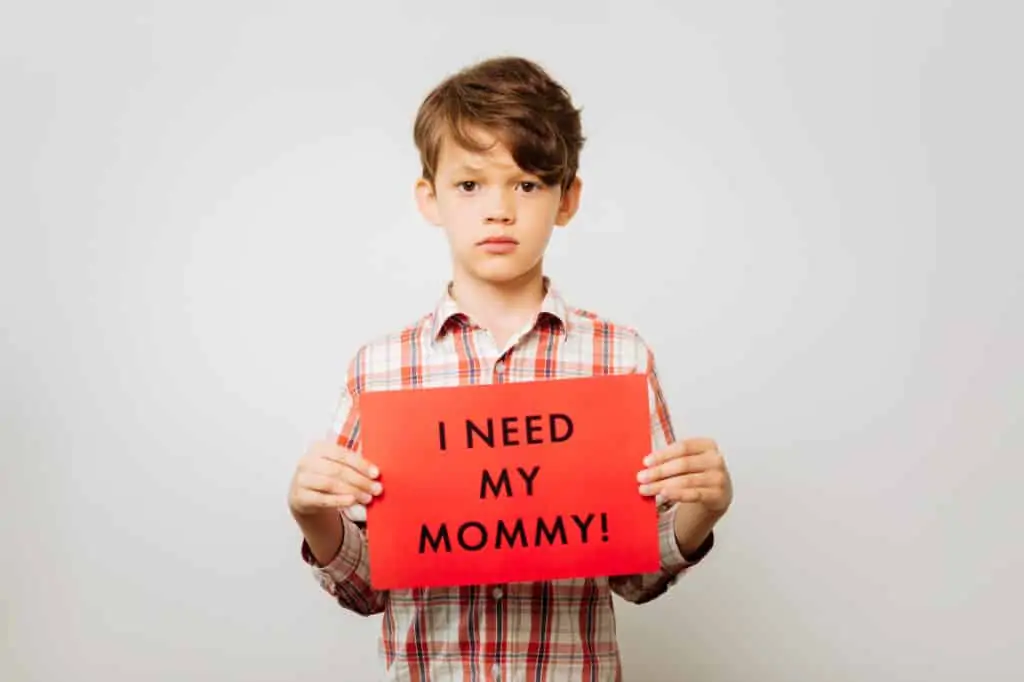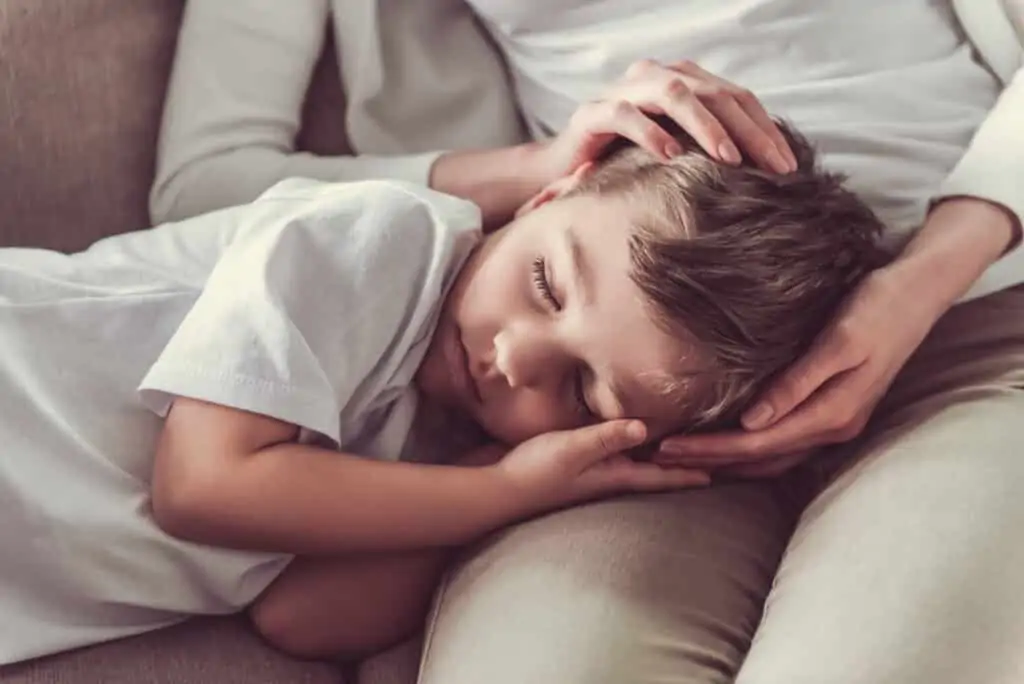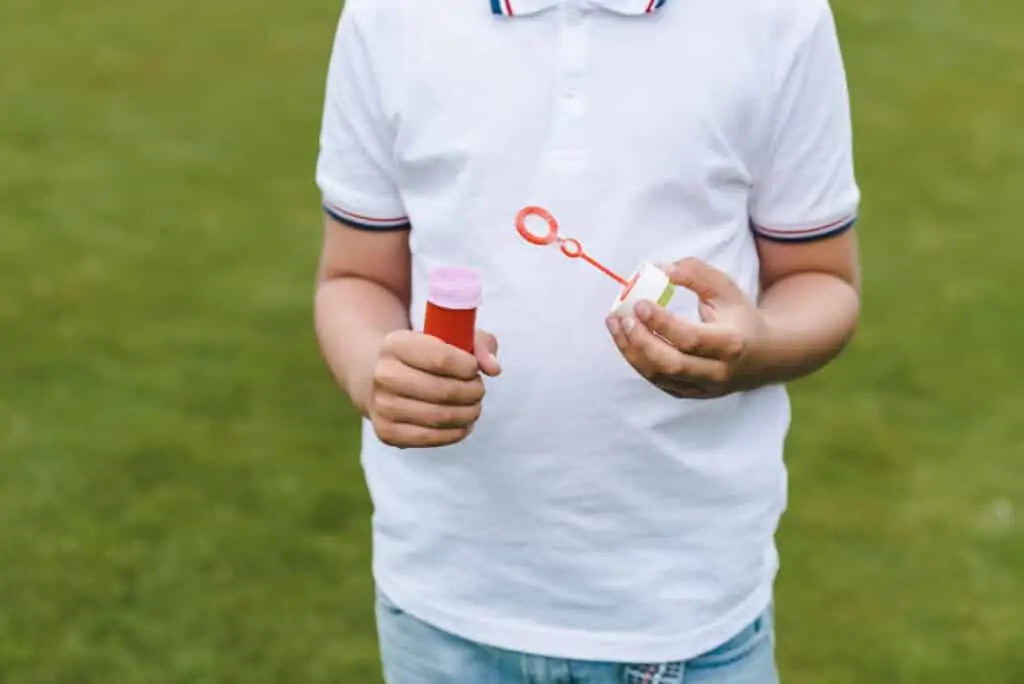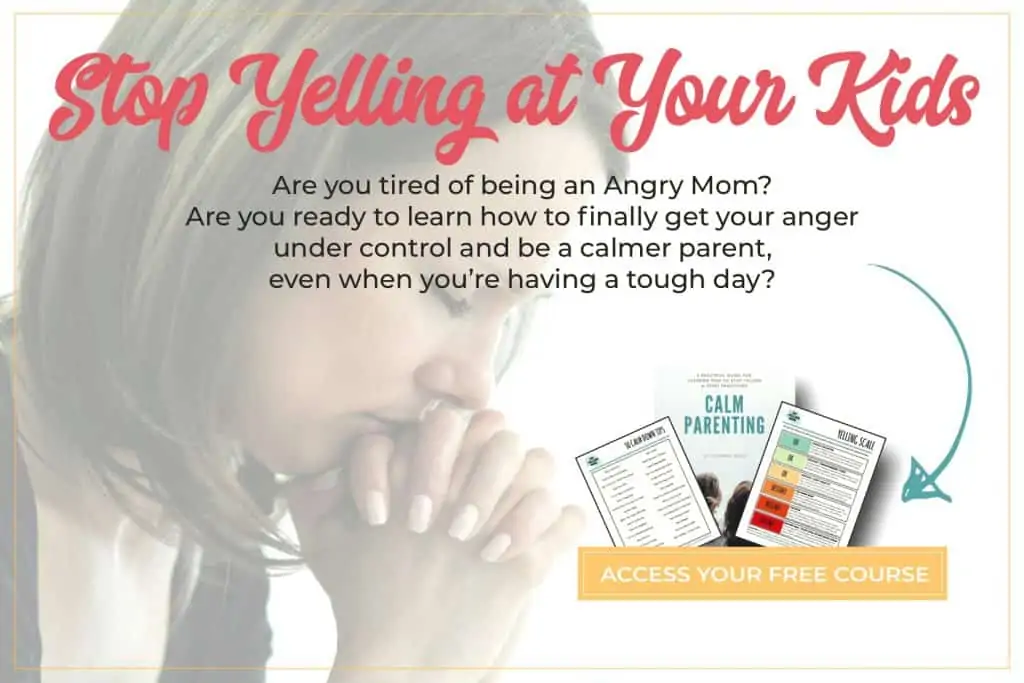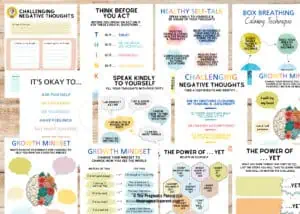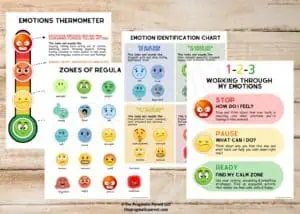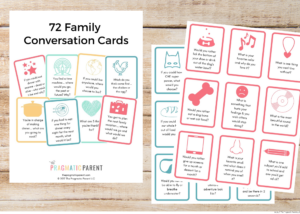Calm an Angry Child… but how? Teaching emotions with the tools in the Emotion identification tools will help them identify, name, communicate their feelings and what’s going on under the surface. The Calm Down Toolkit can help children to develop calm down strategies and self-regulatory methods that work best for them, including mindful breathing and tracing patterns.
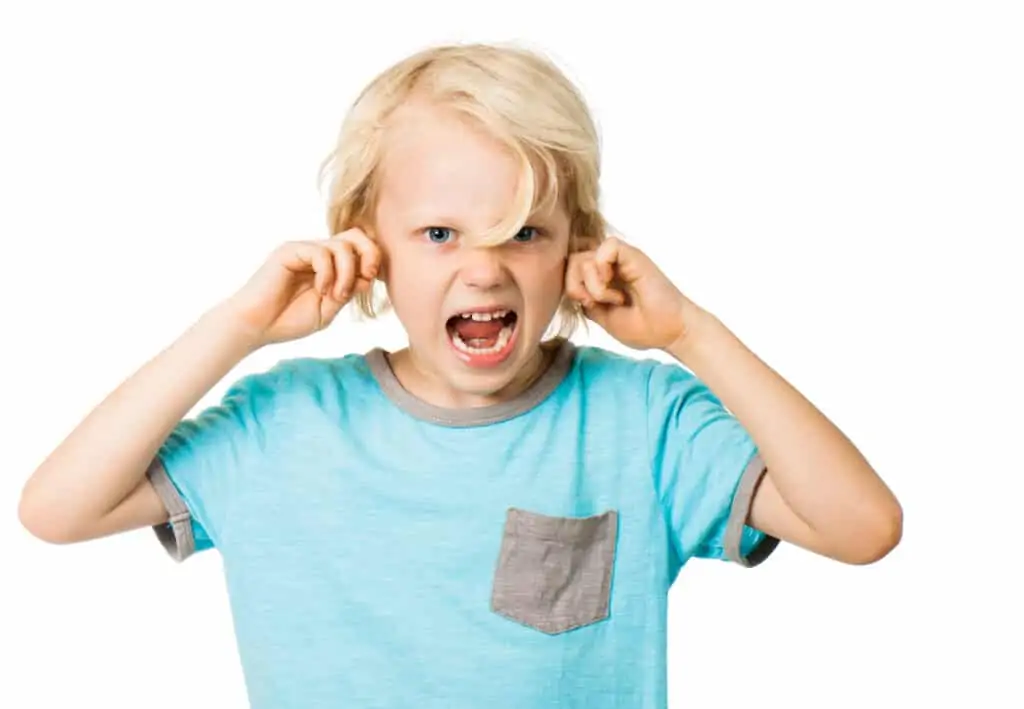
Calm an Angry Child & The Brain Science Behind Outbursts
When your child is in an emotional place, whether they’re frustrated, upset or angry, it’s easy to see how hard it is for them to calm down.
As adults, it’s even hard for us to calm down when we’re in an emotional place. To expect a pint-sized person to do the same as an adult, is well… ten times as hard.
Children who are just learning what they’re emotions are and finding the names to their feelings, need a helpful hand from the adults who care for them.
That’s because there’s a developmental reason behind this stage of learning and calming big emotions.
Teaching kids to deal with their anger in healthy ways is an important life tool and it starts around the ripe old age of three to four.
A lot of the solutions you’ll read here, give kids a physical outlet for the big emotions they’ve kept bottling up inside.
That’s the key – finding physical outlets.
The Brain Science Behind Kid’s Brain Development
First… let’s talk about the brain science of kid’s development behind big emotions.
When we talk about anger, as adults, we can deduce where it comes from, how it feels and ways to stop it.
Kids can’t do the math like we can and it’s not because they aren’t smart; it’s simply because of what stage of brain development your child is in, that they physically can’t.
There are three parts of brain development and the brain won’t fully mature until the age of 24.
That’s why it’s important to remember you’re dealing with brain development and all the wiring that leads to emotions, self-control and decision-making, is not yet fully developed.
One way to think of the complex workings of the brain is to look at it as three parts: lower, middle and higher brain.
Here’s a quick video about the three parts of a child’s developing brain:
1. Lower Brain
The lower part of the brain is the alarm center and it’s main job is to SURVIVE.
This is the most developed part of the brain babies are born with and it’s job is to alert you by crying when the brain tells the body it’s hungry, needs sleep, controls breathing, responds to danger and regulates circulation.
The lower brain responds to danger by enacting the fight or flight (also called fight or freeze) instinct.
Here’s behavior that happens when you’re in the lower brain:
- Hungry
- Tired
- Scared
- Need Comfort
2. Middle Brain
The next part of the brain is called the middle brain. Some refer to is as the EMOTIONAL BRAIN.
Children, from birth until the age of 7, live in the emotional brain.
This part of the brain is focused on feelings, feelings and more feelings!
The primary focus is the amygdala which is the emotional center of the brain.
Since kids operate primarily from their emotional center of the brain for the first seven years of life, we can truly say they are just “acting their age.”
Here’s behavior that happens when you’re in the middle brain:
- Meltdowns
- Outbursts and Tantrums
- Bursts of Anger / Yelling (adults and kids)
- Talking Back
Using emotion picture cards can help kids understand the big swirl of feelings inside.
Since little ones are primarily visual learners until elementary school age, being able to label a reaction with a name such as anger, jealousy, unheard, not only empowers them but helps when they feel ready to communicate their feelings with you, or another person.
In addition, the Emotion identification tools will help them identify, name, communicate their feelings and what’s going on under the surface.
3. Higher Brain
The longest developing part of the brain which takes until the age of 24 to fully mature, is the higher brain.
This is the rational center (also know as the neocortex or frontal lobes.)
The rational part of the brain manages reasoning, rational thought, problem-solving, self-control, concern for self and others, creativity, imagination, discipline, kindness and empathy.
In other words, this is all the good stuff that makes us mature adults who are kind, interesting, and level-headed.
The higher brain rapidly starts development around 7 years of age but doesn’t fully mature until the age of 24.
The higher brain makes us who we are, but takes the longest time to fully develop.
Fluctuating Between Brain Levels
Even as adults, we don’t always stay in the higher brain.
Sometimes we can be triggered to move into our middle brain (like when we raise our voice,_ and even lower brain if we are forced into fight or flight mode.
Understanding this information about the three parts of the brain helps us understand meltdowns, outbursts and challenging behavior – at any age.
We can stop and ask ourselves, “what part of the brain is this behavior coming from?”
Moving from one part of the brain to the next is normal, but when a child or adult moves from the higher brain to the middle brain, they often can get stuck, because the higher center of the brain shuts down.
The higher brain or rationale brain is where reasoning and rational thought takes place.
When it shuts down, you can’t access these valuable tools until the feelings in the emotional brain have had time to cool off.
When your child is stuck in the emotional center of the brain, the middle brain, you can’t reason with them because they cannot access the rational part of their brain.
There is simply no way you’ll be able to get through to them.
This goes for adults too. If you are triggered, you won’t be able to access your higher brain either.
Knowing this, it’s not wonder we often get big emotional displays from our kids that seem to go on forever, and getting down to eye level or talking gently to them rarely helps.
What can help then?
What Your Angry Child Needs
When your child is upset, they are functioning in the middle brain… a highly emotional state.
Remember, this is where the connection to the higher brain is lost which means there’s no rational thinking, no ability to reason internally and calm down, or logically problem-solve a solution to the problem.
This is why I tell parents, and sometimes even have to remind myself, that the last thing your child needs when they’re having a meltdown is for you to try to parent them.
Instead, what they need is time to get all their big emotions out.
When you child is having a meltdown, or tantrum or angry outbursts, they’re not trying to control the situation. Actually, they’re having a meltdown because they can’t control their emotions.
How many times have you tried to get down to eye level with your child when they’re upset about something, to keep you voice calm, and say, “use your words,” “I can’t understand you if you don’t tell me what’s wrong,” or “please stop,” only to watch their emotional volcano erupt all over again?
It’s not because you child refuses to stop melting down or is unwilling to stop their explosive emotions – it’s that they physically cannot.
When a child is in the thrones of the middle brain meltdown, the best thing you can do is to let it run it’s course and give them a way to release their bottled up emotions.
Resource: The Calm Down Toolkit can help children to develop calm down strategies and self-regulatory methods that work best for them, including mindful breathing and tracing patterns.
What Can I Do to Help My Upset Child?
Imagine a soda can.
You take the soda can and shake it hard, up and down, for a few seconds.
The pressure builds.
The can swells and you can feel the force inside push outwards.
And just like the soda can, your child needs a way to release everything that’s been built up inside.
This is where you give your child space, but also a physical outlet to release what’s been shaken inside.
Physical Outlets to Help an Angry Child Calm Down
Below I have listed a number of ways that should help you and your child deal with anger, being upset and big emotions.
- Exercise or do a sport like karate, that helps her get her anger out at other times while learning self-control.
- Put heavy covers or a weighted blanket on their body. The pressure from the heaviness is calming.
- Have them punch a pillow or punching bag.
- Blow bubbles which teaches kids to take deep breathes, which soothes them.
- Run around the backyard or go on a walk together.
- Use a straw and blow a small toy, button or light object across the table. Too big of a breathe will push the object off the edge so the child will need to control their breathing to get it safely from one side to the other without going over the edge.
- Jump on a trampoline. We put one of these trampolines in the basement for our kids to use especially for this reason!
- Take a warm bath. The combination of warmth and water is calming.
- Squeeze something tightly like a stress ball or putty.
- Give them a stack of paper or a recycled newspaper to rip and shred.
- Have them shoot hoops and get some fresh air at the same time.
- Use Calm Down Picture Cards so your child can choose what they think would help the most.
After The Child has Calmed Down
The most important part of anger training doesn’t happen when the child is angry.
It happens after they have calmed down and are open and ready to talk.
This is when you need to work with them to discuss feelings, appropriate behavior, role-play appropriate reactions and set ground rules about angry behavior. (it’s okay to be angry, but it’s not okay to hurt yourself, others or property.)
Acknowledge your child’s feelings with statements like:
- “I understand you’re angry, and it wasn’t OK for your sister to take your toys, but I’m not going to let you hurt her.”
- “I can tell you felt left out when the neighbors didn’t want to play, but…”
There are all kinds of personalities in this world, and some run hotter than others. It’s our job as parents to help them learn how to navigate their emotions and communicate in healthy ways.
The research is crystal clear that when kids feel warmth and affection from their parents, and especially as we’re teaching them about how to regulate their emotions, this will have a life-long positive impact on the child.
Parental warmth even has an impact on your child’s physical health.
It takes patience and training from a parent to know how to help your kids learn to deal with their emotions, but the rewards are enormous.
More Help to Calm an Angry or Upset Child
- Emotion identification tools will help them identify, name, communicate their feelings
- The Calm Down Toolkit can help children to develop calm down strategies and self-regulatory methods
- Anger Management for Kids: 10 Ways Parents Can Help Kids Calm Down
- How to Stay Calm When Your Child Misbehaves
- 7 Ways to Help Kids Identify Feelings & Control Emotions
- 6 Ways to Help Children Identify & Express Their Emotions
- Parents: 5 Steps to Teach Kids How to Manage Big Emotions (Free Printable)
